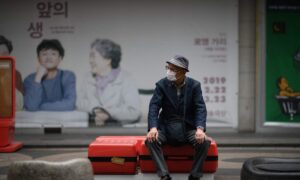Sales of adult diapers in South Korea surpassed those of infant diapers in 2021, according to government data on Tuesday, a trend presumably prompted by the country’s aging population and declining birth rate.
South Korea produced and imported 112,000 tonnes of adult disposable diapers in 2021, an increase from 86,000 tonnes in the previous year, Chosun Ilbo reported, citing data from the Ministry of Food and Drug Safety.
The report states that South Korea’s adult diaper sales outpaced baby diaper sales by 1.6 times in 2021, with baby diaper production and import declining from 76,000 tonnes in 2019 to 69,000 tonnes in 2020.
The market trend suggests that some diaper makers have shifted demographics, as the share of the country’s population aged 65 and older is projected to increase to 46.4 percent by 2070.
Declining Fertility Rate
The country’s population shrank for the first time in 2021, stoking worry that a declining population could severely damage the economy because of labor shortages and greater welfare spending as the number of older people increases and the number of taxpayers shrinks.
South Korea’s statistics agency announced in September last year that the total fertility rate—the average number of babies born to each woman in their reproductive years—was 0.81 in 2021. That’s the world’s lowest for the third consecutive year.
President Yoon Suk Yeol has ordered policymakers to find more effective steps to deal with the problem. The fertility rate, he said, is plunging even though South Korea spent 280 trillion won ($210 billion) over the past 16 years to try to turn the tide.
Many young South Koreans say that, unlike their parents and grandparents, they don’t feel an obligation to have a family. They cite the uncertainty of a bleak job market, expensive housing, gender and social inequality, low levels of social mobility, and the huge expense of raising children in a brutally competitive society.
Women also complain of a persistent patriarchal culture that forces them to do much of the childcare while enduring discrimination at work.
“In a nutshell, people think our country isn’t an easy place to live,” said Lee So-Young, a population policy expert at the Korea Institute for Health and Social Affairs. “They believe their children can’t have better lives than them, and so question why they should bother to have babies.”
Japan’s Aging Population
Aside from South Korea, Japan also struggles with a declining birth rate. Prime Minister Fumio Kishida said last month that Japan will cease to function as a society if its birth rate continues to decline.
“Japan is at a critical point of whether we can continue to function as a society. Focusing on policies regarding children and child-rearing is an issue that cannot be postponed,” Kishida said at a parliament session.
According to Kishida, the government would increase its spending on child-related programs and establish a children and families agency in April to develop policies on children and child-rearing.
“We must establish a children-first economic society and turn around the birth rate,” he stated. “We will also work on the introduction of a career-based scholarship system to reduce the burden of higher education.”
Japan has, in recent years, offered cash bonuses and childcare incentives to encourage people to have more children, but these efforts have had little impact.
The nation’s population currently stands at 125 million and has been in continuous decline for 14 years. Kishida said that the number of births dropped below 800,000 last year, citing government estimates.
Nearly 28 percent of Japan’s population was over the age of 65 in 2017, and this figure is projected to increase to 38.4 percent in 2065, according to a study published by Global Health and Medicine. The working-age population in Japan is shrinking even more quickly due to aging.
The ASEAN+3 Macroeconomic Research Office (AMRO) revealed in a 2019 report that Japan’s working-age population dropped from 87 million in 1993 to 75.3 million in 2018, resulting in a severe labor shortage in the country’s economy.
The Associated Press contributed to this report.
THE FIRST E-COMMERCE SPECIALIZED ON TRUFFLES AND TRUFFLE PRODUCTS – TRUFFLEAT.IT

